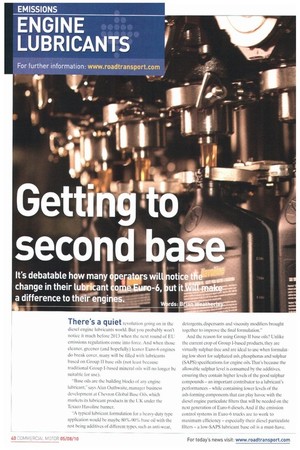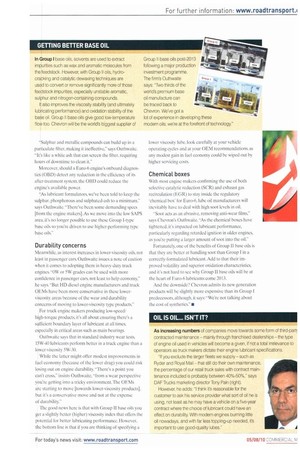secciti
Page 40

Page 41

If you've noticed an error in this article please click here to report it so we can fix it.
It's debatable how many operators will change in their lubricant come EuFo-6, a difference to their engines.
There's a quiet revolution going, on in the diesel engine lubricants world. But you probably won't notice it much before 2013 when the next round of EC emissions regulations come into force. And when those cleaner, greener (and hopefully) leaner Euro-6 engines. do break cover, many will be lilled with lubricants based on Group II base oils (not least because traditional Group I-based mineral oils will no longer be suitable for use).
"Base oils are the building blocks of any engine lubricant,says Alan Outhwaite. manager business development at Chevron Global Base Oils, which markets its lubricant products in the UK under the Texaco Havoline banner.
"A typical lubricant formulation for a heavy-duty type application would be maybe 80%-90% base oil with the rest being additives of different types. such as anti-wear, detergents, dispersants and viscosity modifiers brought together to improve the final formulation."
And the reason for using Group II base oils? Unlike the current crop of Group I-based products, they are virtually sulphur-free and are ideal to use when formulating low short for sulphated ash, phosphorus and sulphur (SAPS) specifications for engine oils."Ibat's because the allowable sulphur level is consumed by the additives, ensuring they contain higher levels of the good sulphur compounds— an important contributor to a lubricant's performances— while containing lower levels of the ash-forming components that can play havoc with the diesel engine particulate filters that will he needed on the next generation of Euro-6 diesels And if the emission control systems in Euro-6 trucks are to work to maximum efficiency — especially their diesel particulate filters — a low-SAPS lubricant base oil is a must-have. "Sulphur and metallic compounds can build up in a particulate filter, making it ineffective," says Outhwaite. "It's like a white ash that can screen the filter, requiring hours of downtime to clean it."
Moreover, should a Euro-6 engine's onboard diagnostics (OBD) detect any reduction in the efficiency of its after-treatment system. the 0111) could reduce the engine's available power.
As lubricant formulators, we've been told to keep the sulphur, phosphorous and sulphated-ash to a minimum,says Outhwaite.—There've been some demanding specs [from the engine makers]. As we move into the low SAPS area, it's no longer possible to use these Group 1-type has oils so you're driven to use higher-performing type base oils."
Durability concerns Meanwhile, as interest increases in lower-viscosity oils, not least in passenger cars. Outhwaite issues a note of caution when it comes to adopting them in heavy-duty truck engines. -OW or 5W grades can be used with more confidence in passenger cars, not least to help economy." he says. "But HD diesel engine manufacturers and truck OEMs have been more conservative in these lowerviscosity areas because of the wear and durability concerns of moving to lower-viscosity type products."
For truck engine makers producing low-speed/ high-torque products. it's all about ensuring there's a sufficient boundary layer of lubricant at all times, especially in critical areas such as main bearings.
Outhwaite says that in standard industry wear tests. ]5W-40 lubricants perform better in a truck engine than a lower-viscosity 5W-30.
While the latter might offer modest improvements in fuel economy (because of the lower drag) you could risk losing out on engine durability. .."1-he re's a point you can't cross." insists Outhwaite. "from a wear perspective you're getting into a tricky environment. The OEMs are starting to move [towards lower-viscosity products]. but it's a conservative move and not at the expense of durability."
The good news here is that with Group II base oils you get a slightly better (higher) viscosity index that offers the potential for better lubricating performance. However, the bottom line is that if you are thinking of specifying a
lower viscosity lube, look carefully at your vehicle operating cycles and at your OEM recommendations. as any modest gain in fuel economy could be wiped out by higher servicing costs.
Chemical boxes
With most engine makers confirming the use of both selective catalytic reduction (SCR) and exhaust gas recirculation (EGR) to stay inside the regulatory 'chemical box' for Euro-6, lube oil manufacturers will inevitably have to deal with high soot levels in oil.
-Soot acts as an abrasive, removing anti-wear films," says Chevron's Outhwaite. "As the chemical boxes have tightened. it's impacted on lubricant performance, particularly regarding retarded ignition in older engines. as you're putting a larger amount of soot into the oil,"
Fortunately, one of the benefits of Group It base oils is that they are better at handling soot than Group I in a correctly-formulated lubricant, Add to that their improved volatility and superior oxidation characteristics, and it's not hard to sec why Group II base oils will be at the heart of Euro-6 lubricants come 2013.
And the downside'? Chevron admits its new generation products will be slightly more expensive than its Group I predecessors. although. it says: "We're not talking about the cost of synthetics" II
























































































































